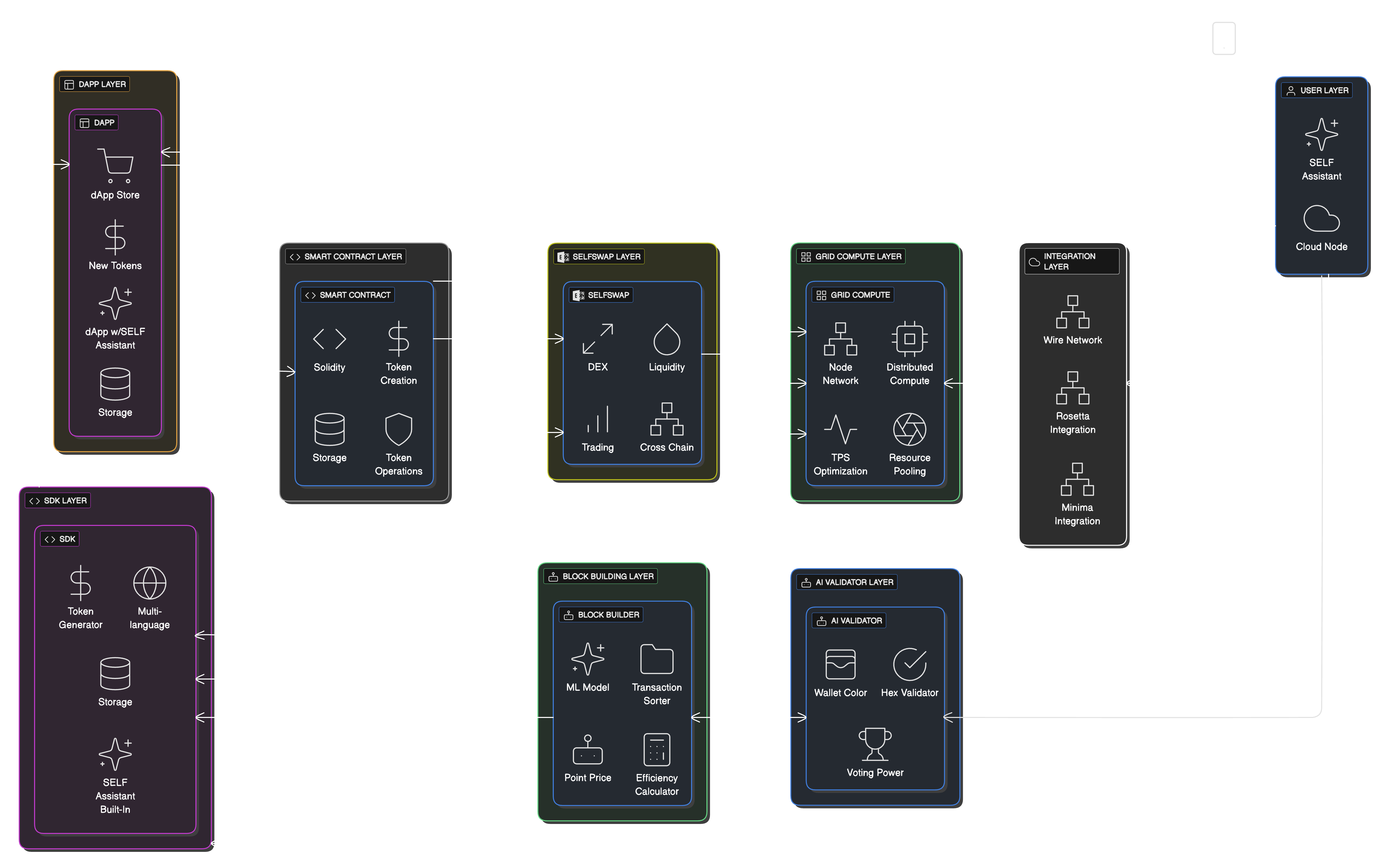SELF Chain Public Architecture
📂 Explore the Open Source Code
Our blockchain implementation is open source. Explore the core components:
- Blockchain Core - Core blockchain implementation
- Block structure, chain management, transaction processing
- Consensus (PoAI) - Proof of AI consensus mechanism
- Validator logic, voting system, reputation management
- Networking - P2P and cloud communication
- libp2p integration, TLS security, cloud protocol
- Storage - Hybrid distributed storage
- IPFS integration, OrbitDB, cloud storage adapters
- Cryptography - Post-quantum security
- Kyber, SPHINCS+, hybrid cryptographic systems
- AI Integration - AI-powered validation system
- Pattern analysis, context management, validation services
👨💻 Developer Resources
Get started building on SELF Chain:
- Getting Started Guide (Testnet) - Begin your journey with SELF Chain development
- Testnet setup, configuration, and safety guidelines
- Public Interfaces Specification - Security-safe APIs for developers
- Understand what can be safely accessed and built upon
SELF Ecosystem Overview

SaaS Platform Model
SELF Chain operates as a managed service platform:
-
User Node Provisioning
- Automatic node deployment when users create a SELF account
- Free trial period with managed infrastructure
- Subscription-based model after trial period
- Seamless transition between free and paid tiers
-
AI Model Integration
- Default AI model provided with each user account
- User-configurable AI preferences stored persistently
- Model upgrade options for subscription users
- Custom AI training with user preferences
-
Super-App Integration
- Blockchain nodes integrated with SELF Super-App
- Cross-app communication protocols
- Persistent user data synchronization
- Unified authentication and authorization
B2B Constellation Architecture
SELF provides enterprise-grade blockchain solutions:
-
Corporate Layer-1 Chains
- Managed provisioning of parallel Layer-1 blockchains
- Similar to Polkadot parachains but for full Layer-1 chains
- Configurable AI model deployment for enterprise nodes
- Custom token generation capabilities
-
Enterprise Management
- SaaS management of corporate blockchain infrastructure
- Monitoring and health dashboards for enterprise clients
- Resource allocation and scaling for business needs
- Enterprise billing and subscription management
-
Ecosystem Interoperability
- Inter-chain communication between SELF and corporate chains
- Shared security and validation model
- Cross-chain transactions and data sharing
- Unified analytics and monitoring
1. Core Architecture
1.1 Cloud-First Architecture
SELF Chain operates exclusively in a cloud-first environment:
-
Cloud Processing
- All operations occur in the cloud
- Distributed cloud nodes
- Secure cloud storage
- Cloud-optimized processing
-
Cloud Infrastructure
- Fully distributed cloud nodes
- Secure cloud storage
- Encrypted cloud communication
- Cloud-optimized infrastructure
-
Remote Access
- Cloud-only interaction model
- Secure cloud APIs
- Remote-first user experience
1.2 Network Architecture
1.2.1 Peer Discovery
- Periodic peer discovery from bootstrap nodes
- Peer-to-peer discovery through known peers
- Peer stats tracking and reliability scoring
- Network topology metrics
1.2.2 Message Routing
- Gossipsub for message propagation
- Kademlia for peer discovery
- Routing table with peer statistics
- Message forwarding with TTL
- Flood threshold protection
1.2.3 Connection Management
- Connection pooling per peer
- Connection timeout handling
- Active connection tracking
- Error handling and recovery
1.3 Storage Architecture
1.3.1 Hybrid Storage
- Decentralized storage using IPFS
- Real-time database with OrbitDB
- Cross-chain data synchronization
- Secure data integrity
1.3.2 Storage Features
- Distributed data storage
- Data versioning
- Data integrity verification
- Secure access control
2. Security Architecture
2.1 Network Security
-
Connection Security
- TLS encryption for all peer connections
- Message signing and verification
- Peer authentication
- Network message validation
-
Data Security
- End-to-end encryption
- Message integrity verification
- Secure data storage
- Access control
2.2 AI Security
-
AI Validation
- Ollama Cloud integration
- Context-aware validation
- Validator reputation system
- Secure AI processing
-
Security Features
- Secure cloud APIs
- Encrypted cloud channels
- Cloud node authentication
- Distributed cloud security
3. Performance Optimization
3.1 Network Optimization
3.1.1 Connection Pooling
- Limits concurrent connections per peer
- Prevents resource exhaustion
- Optimizes network bandwidth usage
- Reduces connection overhead
3.1.2 Routing Optimization
- Intelligent peer selection
- Path optimization
- Load balancing
- Error recovery
3.2 Storage Optimization
- Optimized data synchronization
- Efficient data retrieval
- Resource utilization
- Performance monitoring
4. Monitoring and Metrics
4.1 Network Metrics
- Peer connection statistics
- Message latency
- Network throughput
- Error rates
- Peer reliability scores
4.2 Performance Metrics
- Connection pool utilization
- Message delivery success rates
- Network congestion levels
- Resource usage
- Storage performance
5. Future Enhancements
5.1 Network Improvements
- Advanced peer selection algorithms
- Dynamic routing optimization
- Enhanced security features
- Improved error recovery
- Advanced monitoring capabilities
5.2 Storage Improvements
- Enhanced data synchronization
- Improved data integrity
- Optimized storage performance
- Advanced access control
5.3 Security Enhancements
- Enhanced cloud security
- Improved encryption
- Better access controls
- Advanced monitoring
6. Documentation References
- Ollama Cloud: https://ollama.ai/docs
- IPFS: https://docs.ipfs.tech/
- OrbitDB: https://orbitdb.org/docs/
- Network Protocols: https://libp2p.io/docs/